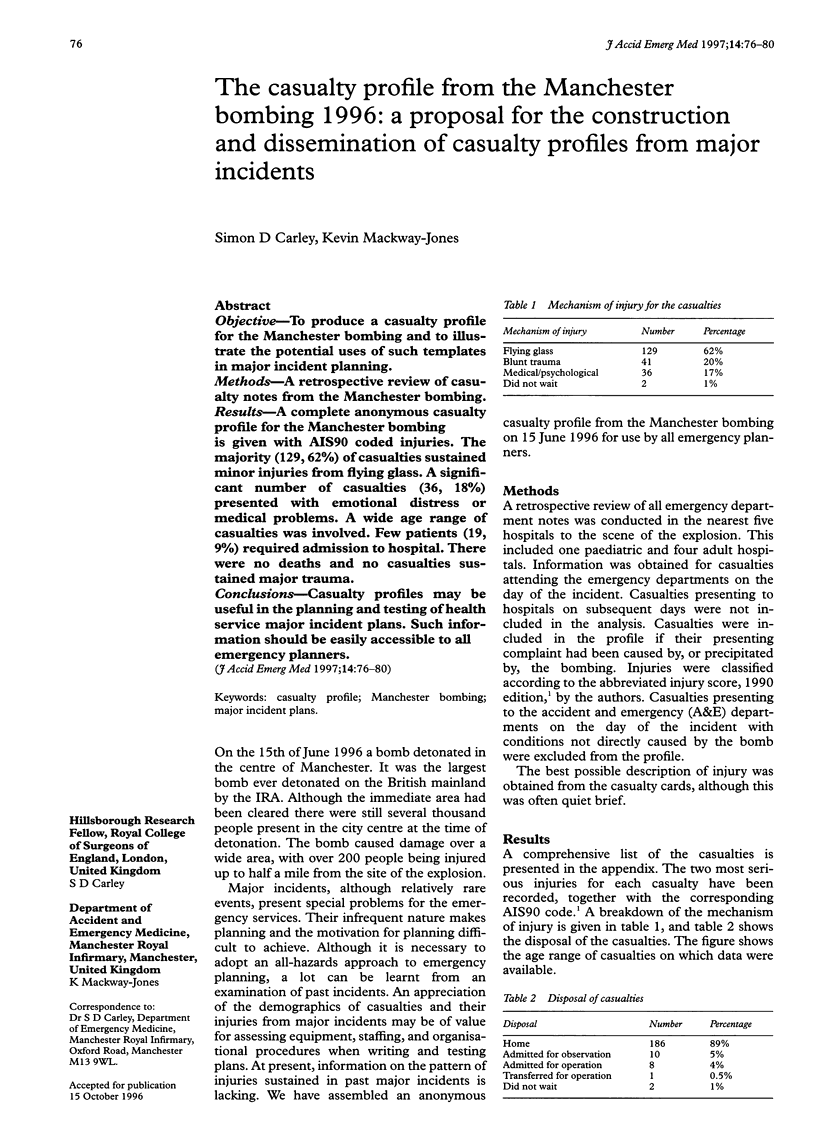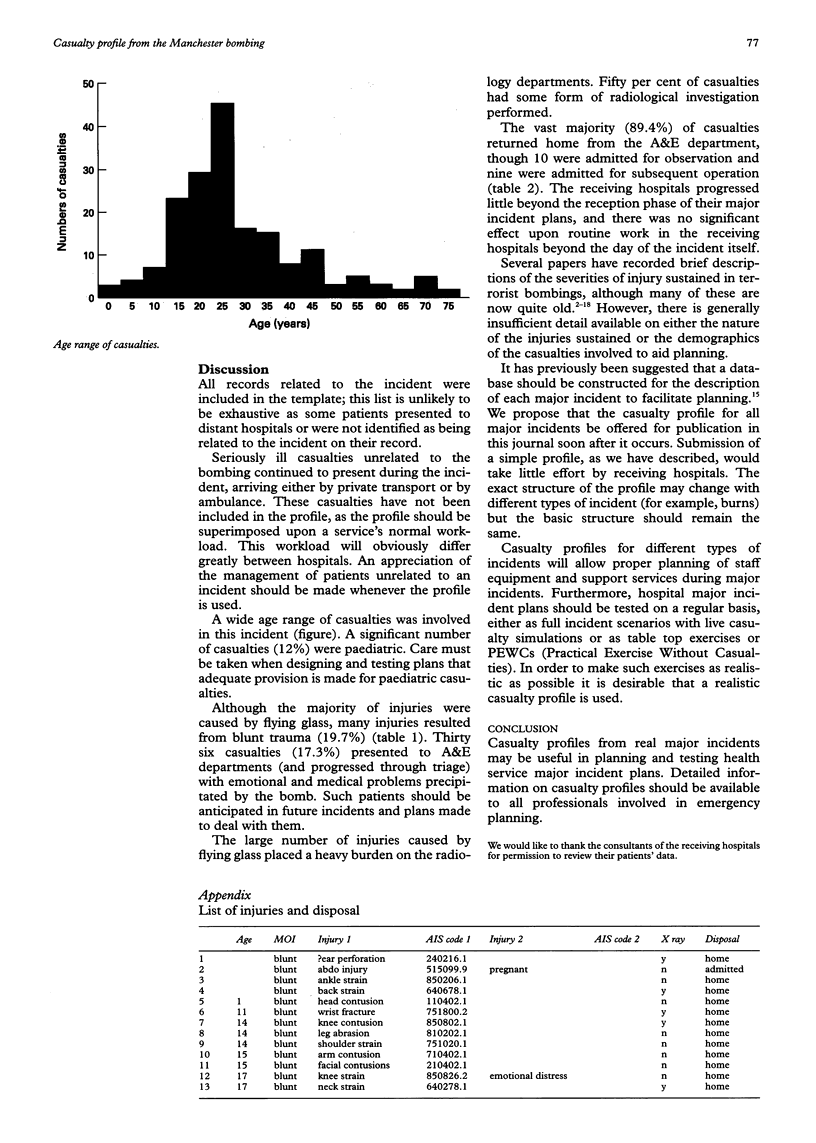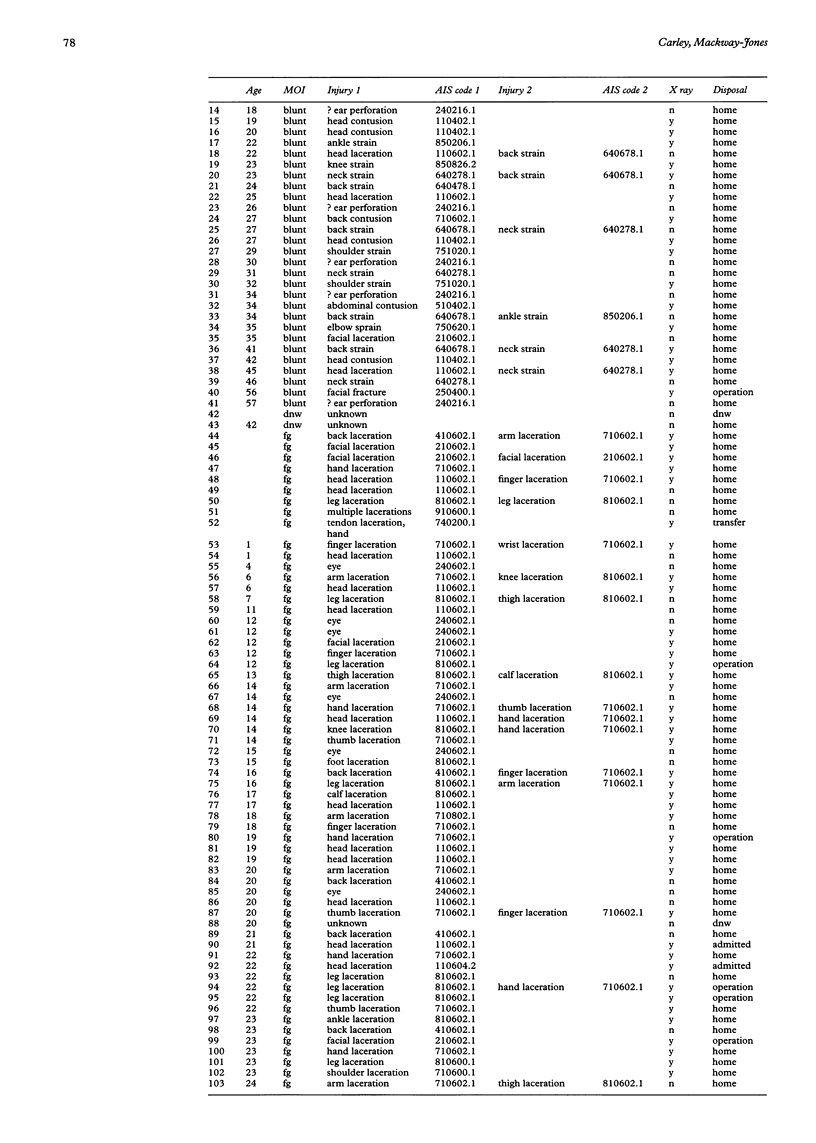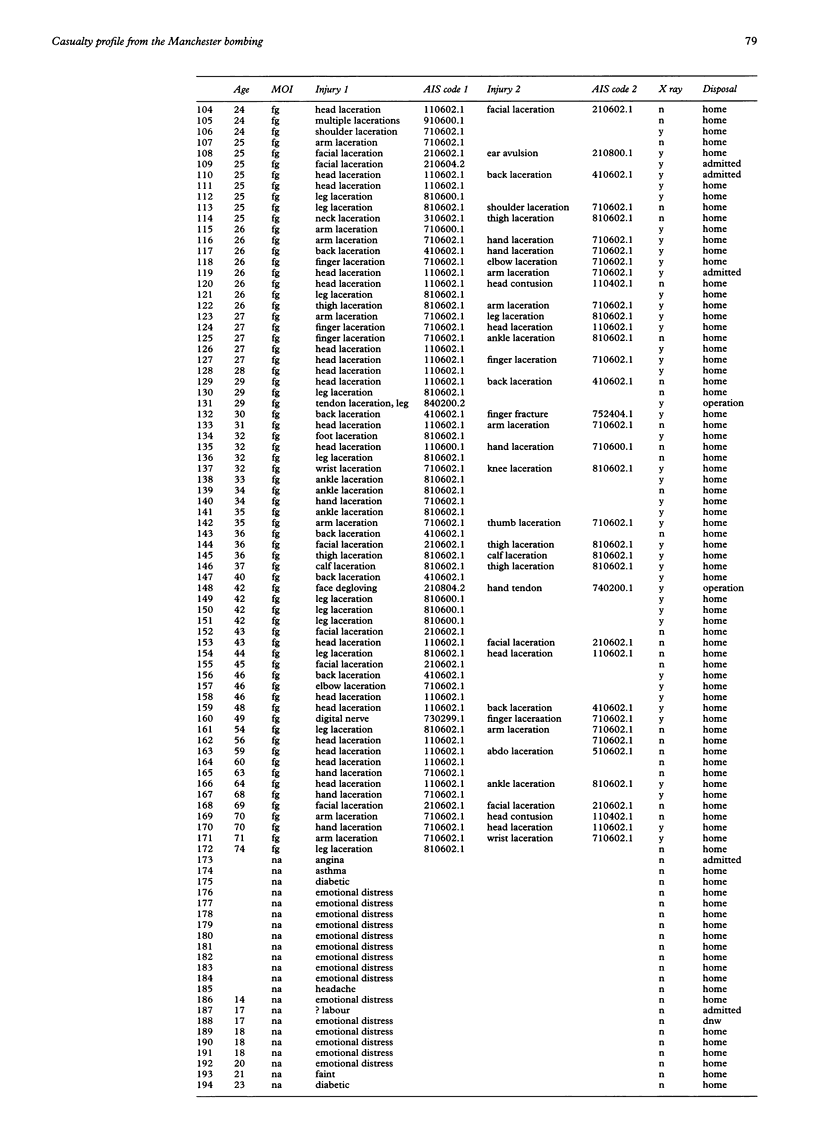Abstract
OBJECTIVE: To produce a casualty profile for the Manchester bombing and to illustrate the potential uses of such templates in major incident planning. METHODS: A retrospective review of casualty notes from the Manchester bombing. RESULTS: A complete anonymous casualty profile for the Manchester bombing is given with AIS90 coded injuries. The majority (129, 62%) of casualties sustained minor injuries from flying glass. A significant number of casualties (36, 18%) presented with emotional distress or medical problems. A wide age range of casualties was involved. Few patients (19, 9%) required admission to hospital. There were no deaths and no casualties sustained major trauma. CONCLUSIONS: Casualty profiles may be useful in the planning and testing of health service major incident plans. Such information should be easily accessible to all emergency planners.
Full text
PDF




Images in this article
Selected References
These references are in PubMed. This may not be the complete list of references from this article.
- Adler J., Golan E., Golan J., Yitzhaki M., Ben-Hur N. Terrorist bombing experience during 1975-79. Casualties admitted to the Shaare Zedek Medical Center. Isr J Med Sci. 1983 Feb;19(2):189–193. [PubMed] [Google Scholar]
- Brismar B., Bergenwald L. The terrorist bomb explosion in Bologna, Italy, 1980: an analysis of the effects and injuries sustained. J Trauma. 1982 Mar;22(3):216–220. doi: 10.1097/00005373-198203000-00007. [DOI] [PubMed] [Google Scholar]
- Brown M. G., Marshall S. G. The Enniskillen bomb: a disaster plan. BMJ. 1988 Oct 29;297(6656):1113–1116. doi: 10.1136/bmj.297.6656.1113. [DOI] [PMC free article] [PubMed] [Google Scholar]
- Caro D., Irving M. The Old Bailey bomb explosion. Lancet. 1973 Jun 23;1(7817):1433–1435. doi: 10.1016/s0140-6736(73)91753-4. [DOI] [PubMed] [Google Scholar]
- Cooper G. J., Maynard R. L., Cross N. L., Hill J. F. Casualties from terrorist bombings. J Trauma. 1983 Nov;23(11):955–967. doi: 10.1097/00005373-198311000-00001. [DOI] [PubMed] [Google Scholar]
- Frykberg E. R., Tepas J. J., 3rd Terrorist bombings. Lessons learned from Belfast to Beirut. Ann Surg. 1988 Nov;208(5):569–576. doi: 10.1097/00000658-198811000-00005. [DOI] [PMC free article] [PubMed] [Google Scholar]
- Hadden W. A., Rutherford W. H., Merrett J. D. The injuries of terrorist bombing: a study of 1532 consecutive patients. Br J Surg. 1978 Aug;65(8):525–531. doi: 10.1002/bjs.1800650802. [DOI] [PubMed] [Google Scholar]
- Hodgetts T. J. Lessons from the Musgrave Park Hospital bombing. Injury. 1993 Apr;24(4):219–221. doi: 10.1016/0020-1383(93)90171-2. [DOI] [PubMed] [Google Scholar]
- Johnstone D. J., Evans S. C., Field R. E., Booth S. J. The Victoria bomb: a report from the Westminster Hospital. Injury. 1993;24(1):5–9. doi: 10.1016/0020-1383(93)90072-e. [DOI] [PubMed] [Google Scholar]
- Kennedy T. L., Johnston G. W. Surgery of violence. 1. Civilian bomb injuries. Br Med J. 1975 Feb 15;1(5954):382–383. doi: 10.1136/bmj.1.5954.382. [DOI] [PMC free article] [PubMed] [Google Scholar]
- Mallonee S., Shariat S., Stennies G., Waxweiler R., Hogan D., Jordan F. Physical injuries and fatalities resulting from the Oklahoma City bombing. JAMA. 1996 Aug 7;276(5):382–387. [PubMed] [Google Scholar]
- Rignault D. P., Deligny M. C. The 1986 terrorist bombing experience in Paris. Ann Surg. 1989 Mar;209(3):368–373. doi: 10.1097/00000658-198903000-00019. [DOI] [PMC free article] [PubMed] [Google Scholar]
- Rutherford W. H. Experience in the accident and emergency department of the Royal Victoria Hospital with patients from civil disturbances in Belfast 1969-1972, with a review of disasters in the United Kingdom 1951-1971. Injury. 1973 Feb;4(3):189–199. doi: 10.1016/0020-1383(73)90038-7. [DOI] [PubMed] [Google Scholar]
- Rutherford W. H. Experience in the accident and emergency department of the Royal Victoria Hospital with patients from civil disturbances in Belfast 1969-1972, with a review of disasters in the United Kingdom 1951-1971. Injury. 1973 Feb;4(3):189–199. doi: 10.1016/0020-1383(73)90038-7. [DOI] [PubMed] [Google Scholar]
- Scott B. A., Fletcher J. R., Pulliam M. W., Harris R. D. The Beirut terrorist bombing. Neurosurgery. 1986 Jan;18(1):107–110. doi: 10.1227/00006123-198601000-00020. [DOI] [PubMed] [Google Scholar]
- Tucker K., Lettin A. The Tower of London bomb explosion. Br Med J. 1975 Aug 2;3(5978):287–290. doi: 10.1136/bmj.3.5978.287. [DOI] [PMC free article] [PubMed] [Google Scholar]
- Waterworth T. A., Carr M. J. Report on injuries sustained by patients treated at the Birmingham General Hospital following the recent bomb explosions. Br Med J. 1975 Apr 5;2(5961):25–27. doi: 10.1136/bmj.2.5961.25. [DOI] [PMC free article] [PubMed] [Google Scholar]



